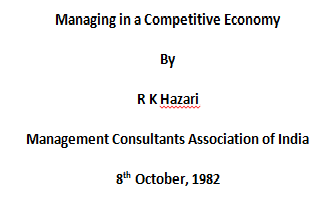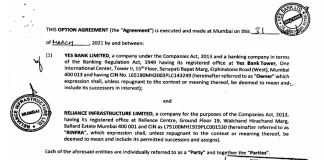Edited transcript of a talk given to The Management Consultants Association of India, 8th October, 1982
BUSINESS STRATEGY
The country is passing through a very difficult transition neither the philosophy nor the planning seems to be capable of holding water. For a long time, we have been accustomed to hear of many things happening in Bihar and Haryana. Regrettably, the rest of the country has also been elevated to the same level. There is an unholy mixture of crime, of politics, and of social tensions. One is reminded that survival itself is a great achievement, but such an achievement, can no longer be taken for granted. The closest historical parallel that I can think of from the record is with the USA of the 1890’s, when there was a painful transition in the thinking of the American people, in the role of the American Government, in the behaviour of the business world, in the conduct of the farming interests America emerged from this severe test, ultimately, as a major power. I hope that ultimately, we would have an equally happy consummation, I may not live to see it, but I do hope that it would be experienced by the next generation. For the time being, the present situation can be summed up, from the business view point, in just one simple statement. The emphasis these days is not on strategy but on transactions, motivated not by thinkers but by operators. May be this is a good thing. This country has never been short of thinkers, maybe we do need operators. But please remember that thinking and operations have to go together. Too much emphasis on one to the neglect of the other does not yield desirable results.
Let me outline the basic facts which cause acute disquiet. There has been a slowing down of the Green Revolution in agriculture during the last few years. We can no longer take the uptrend in agriculture for granted. The growth of food production barely covers the growth of population. The advantage that we had built up since the mid-sixties has petered out. In the last few years, the national growth rate of agriculture has come down to the level in Assam, which has hardly known the Green Revolution, and which has been without a government for some time. We seem to have reached a plateau over which governmental intervention and alleged planned direction do not result in raising the growth rate beyond what the All-Compassionate God would bestow upon us in the normal course.
Further, the situation in respect of electricity and coal is once again causing deep anxiety. There are power cuts all over the country ranging from 30 to 100 per cent and load shedding is no longer confined to the Eastern region. No improvement is likely in the next few months ahead, rather the contrary. The coal delivery position had recorded some improvement last year and earlier this year but now there is deterioration in both quantity and quality.
Allow me to list certain other factors which most people do not like to mention in public, because, may be it is not very safe to mention them. Over the last twelve years or so, there has been an increasing involvement of public financial institutions in the top management of public companies. This involvement was expected to produce certain positive results, some of which have been achieved. Of late, however one does not know what the objectives of the public financial institutions are in terms of management control and in terms of their areas of intervention. There are no clear policy indications about what the Institutions would do with their large holdings in many companies. Are these to be retained? Are they to be sold out? If I they are to be retained, what kind of management control is envisaged? If they are to be sold out, what are the considerations on the basis of which they are to be sold out? And if so, to whom? Where the institutions continue to have large holdings, what are the relationships envisaged between the Institutions inter se, their nominees and representatives and the managements of the companies concerned, and at what points institutional intervention should take place. Twelve years have passed since the Institutions started taking up important positions as shareholders and creditors of large companies, but no systematic management control and reporting system has been developed. This leads to confusion, and often misunderstanding. In many new companies, the insistence on having what is called broad-based representation is leading to unwieldy Boards of Directors, in which it is very difficult to attain homogeneity of outlook or clarity of functions.
Alongside, many large groups which were set up by well known business families have been breaking up. During the last two decades, after my researches acquired some notoriety, we were frequently — and rightly — told that Indian business groups are very small, by international standards, and in terms of the requirements of technology. I have never been against large groups or large firms per se. (I would be glad to hear anything to the contrary from any book or paper that I have written), Now of their own volition or internal combustion, several large business organisations have broken up and some others are likely to break up soon. This creates management strains and impairs the capacity to bear the risks imposed by increasing capital costs of new projects.
Early this year, I had spoken in public about the threat of cannibalism, that is, some companies acquiring other companies. Some of this is inevitable, considering the extremely high capital cost of new investment, and wide differences in management performance. It is a necessary part of the evolution of business in any country. Some of it is certainly desirable. What I am pointing out now is that now cannibalism is taking place and, with the shift in policies in respect of the shareholdings of the institutions, it creates uncertainties for the strategies that top managements have to think of and adopt. The trend is reinforced by reports of changes in the controlling interests held abroad of some foreign-controlled companies. Among other things, it means that the position of top managements is no longer as secure as it was believed to be earlier.
There is also now a confusing mix of professionalisation of technicians and managers in family-controlled enterprises and at the same time deprofessionalisalion manifest in the ambition of some corporate managements with very limited shareholdings to become entrepreneurs through private capital accumulation. Inflation of the cost of living, together with the inflation of aspirations and expectations, results in expenditure beyond the level of post-tax disposable income in hand. Several executive remuneration practices which, say, ten years ago would have been considered inconsistent with professional management have become established practice.
I am not condemning this or that development. I am only pointing out facts. Rapid changes are taking place in business behaviour, and in standards of behaviour. These have implications for business strategy, because, whatever one does has to be viewed relative to the sense of consciousness of the people who make the decisions. There is nothing that is independent of the outlook and interest of those who make the decisions.
Much has been said lately about the effects of import liberalisation. On the whole, I think the policy direction implied in import liberalisation is for the better. It will certainly make people sit up. It has created difficulties for certain industries; especially for those whose inputs are very high priced. But let us not mix up the problems that arise due to essentially domestic reasons and those problems that arise due to import liberalisation. For instance, the problems that have arisen in aluminium and aluminium-using industries like cables are not so much due to import liberalisation as they are attributable to the near-insolvency and poor management of the State Electricity Boards. Had they been functioning properly and buying what they should have been buying in the normal course, this problem would not have acquired the dimensions that it has. There are also some difficulties in exports caused by international recession, but let us not exaggerate these; it certainly affects many industries, but a lot of these problems also arise because our costs all along the line are pretty high. Some of the reasons for the high costs are well known. Let me add one more that I expect to become manifest fairly soon. The only way the government can find more resources in bulk and deal with some of the emerging economic problems is to raise the petroleum prices still further. This will have to come fairly soon if the government has to have enough resources for investment. There is almost no other source that can yield the amounts that we have in mind. We have therefore to live with a situation, in which costs have been high, are high and in many cases will remain high.
It is very difficult to say whether the recession is petering out now. Our data are not as reliable as they should be, but from whatever quick reporting one can get hold of, it is fairly obvious that some of the loud alarms that were being put out five or six months hack are now becoming quieter, partly, because the output and inventories have been adjusted to the new demand levels. Let me come now to more specific ideas for evolving business strategy, We hear a lot about how poor this country is. Repeatedly one is told that, give or take something, about one-half of the population is below the poverty line. This is a very sad fact. From the business strategy viewpoint, I would like to look at the other side of the coin, namely, one-half of the population is above the poverty line and this represents a fairly large demand factor, which we should never ignore in our business calculations. Even though the bulk of the demand may unfortunately, be confined to the top 2% or 5% or 10%, depending upon what markets or products or services one is thinking of, in terms of the numbers of population, involved multiplied by such income or consumption as they have, we get a fairly large universe lo operate on.
Much has been said about the trend of deregulaiion that government is undertaking. I am all for as much de-regulation as possible, I have never been in favour of controls for the sake of controls. Many of the controls that we have had are not essential for planning. Equally, let us be clear, while de-regulation would be most welcome for reducing managerial constraints, it would also be welcome for making the economy more competitive. De-reguIation by itself will not however, produce the results that we need. There will have to be more resources generated for growth, which means (i) the agricultural growth rate will have to be stepped-up and (ii) there will have to be much better management of the public sector and a revival of the real value of public investment. Whatever view one may have about public investment, the fact of the matter is that industry depends ultimately to a very large extent upon the level of real investment in railways, electricity, roads and such other things.
It is hardly appropriate in this audience to talk about expenditure by the government. From the business viewpoint, it is essential that our large companies in particular take an interest in the up-gradation of agricultural growth. This means greater involvement in the production and application of improved seeds, in the extension of better practices and in improving the yields from new inputs. Such investment or organization need not be left wholly to the government. We have reached a stage of evolution and size in the agricultural operations of a vested interest in having a more effective and much larger system of agricultural extension. It would also be necessary for industry lo take a more broad-minded view of participation in agricultural processing. We have reached a stage in levels of agricultural production to think a lot more of processing than we have done in the past. We have a lot of wastage of agricultural production and of by-products. Whether we think of more value-added items or of preservation or more effective marketing, this is a large held which has a lot of profitability ahead, and which would also be consistent with the national interest. Our levels of production have reached a stage where proper marketing cannot be taken for granted. We should not continue with our mistakes in traditional commodities. We have been selling jute as jute ever since we started manufacturing it, and the marketing of raw jute remains highly disorganized. Similarly in cotton, though better organized, we have not been very effective or efficient in adding value. In sugarcane and sugar, we persist with highly wasteful processes. In fruits and vegetables, in which a fair lot of investment has taken place during the last ten years, apple excepted, marketing and processing are primitive, inefficient and unfair.
There is no doubt that the scale of our units is small. There has been some appreciation lately in governmental quarters about the need to increase the size of the new units licensed, but we are still going in for more units than we really need in terms of technology. What I wish to stress just now is that this is outside the control or jurisdiction of business itself. What I would like to stress a lot more is the tact, that, nearly all industry in India is highly materials intensive. By an accident of history or bad planning or wrong ideas, we certainly have high capital costs. Due to poor levels of labour productivity, we certainly have high labour costs. When economists talk about high costs, they think largely of capital cost and of labour cost. This is because economists concentrate on value added, i.e. the value of production less the value of materials. You therefore focus attention on rent, wages, interest, profit. I beg to submit that this is neither a comprehensive nor a managerially meaningful way of looking at costs for current operations. In Indian industry, material costs is 6O to 70% of the total cost. Our materials used to be cheap, therefore, we used them liberally, excessively and almost without regard In costs. We have been accustomed to high inventories. We have also been accustomed to buy at yesterday’s prices and sell at tomorrow’s prices, thereby getting the profits of stock revaluation. If you deflate the performance of most industrial companies by the extent of the profits in inventory valuation, you will uncover substantially different picture from what you see in the published accounts. I am not getting into the problem of revaluation or replacement costing of equipment; I am only talking of current operations. Cost and productivity of materials have to be our principal concern in business strategy, whether the recession lifts or not, whatever the pace of deregulation, and whether the international situation improves or not.
Over the last several years, I have been associated in one capacity or the other, on one side of the fence or the other, with the use of credit controls or financial controls, in order to have a rational working system for the allocation of resources between many competing demands particularly to keep down the level of inventories. Let me tell you of my own experience in a company where there has been no liquidity crunch, and no complaint against the banks, where there has been a consistent demand from the, production people that six months inventory of raw material is absolutely essential because of various uncertainties, shortages, also because of the very important business reason, that if you do not buy today you will be paying 20% more in another 4 months. This is fine, but please add the costs of interest, storage, pilferage, and deterioration. When you really start looking at the inventories you keep, you find that for, no reason other than sporadic availability, inventories of certain items are much more than the norms and much more than what is really required in the near future or that the norms were set three years back, let us say, but they have not been revised, and so you have money tied up in inventory that is not likely to he used up for a year or so. You have mismatched sections of raw materials, e.g., you have more than a year’s inventory of some things and of some other things you have three day’s inventory and by no system of matching can you really make use of those items for which you have stocks for one year or more. I am mentioning these because these are matters of internal control, and while computerisation is useful, a change of outlook is even more essential. We have all been brought up to believe that one should have as much inventory as one can get hold of, one is not really bothered about the cost of inventory. All of us are vaguely aware that materials cost is what matters and any businessman worth his salt knows that his profits come from materials, from where he has bought them, the price at which he has bought them and so forth. But the implication in terms of building up a strategy for the future has seldom been fully thought out. Most traditional businessmen and, I regret to say, even most professional managers have been carried away by the thought that with the inflation that has taken place and may take place again, there is no disadvantage in having large stocks, either of raw materials, or components or what have you. In one leading engineering company (with which I am not connected) a reduction of inventory of about Rs. 14 crores proved possible within a single year, This did not at all hurt the company’s operations to put it mildly. There may be similar scope for better control and improvement of operations in many other companies not only in the public sector, but even in the private sector. While it is true that inventory control in the private sector is far better than that in the public sector, the fact of the matter is that, with greater bureaucratization in business and the ease of inflationary profits, people have believed that large inventories do no harm. Once the internal controls becomes loose on this account, one does not see deleterious effects of high materials costs, combined with the fact that materials are no longer cheap as they used to be. This, I think is one major area of control within the hands of business managements on which attention must be focused in the months and years to come.
I am not going to talk about labour productivity because that is talked about very often — I am not saying this is not important. I am going to talk about a related resource area. We have been accustomed to operate with rather thin executive cadres, partly because executives have come from within the family or at one time they had to come from public schools or, as they used to say, from “good families”. Whether there are traditional family managements or so called professional managements, most companies have so far lived, survived and flourished with very thin executive cadres. We have now reached a situation when we require more and more executives — and we also require a reserve to take care of training, as also of turnover. The days when one look it for granted that a 20 or 33 wear old boy from Cambridge or Oxford or, what have you or, from a good institution in India would be taken in, “trained” for five years and stay with the company for another 30 years, are gone. We have to assume that there would be a high turnover of executives in the years to come. Much as one may dislike it, this has to be accepted as one of the facts of life. Therefore one has to retain one’s thoughts on executive levels, executive productivity and results, and executive longevity from a different viewpoint from what it used to be at one time. No doubt, the cost of executives is small, notwithstanding the number of pages that are devoted to executive remuneration in the annual reports of companies. But the cost is crucial for obtaining results. One needs a different outlook in dealing with executive problems from what it has been either, in the traditional business families or in what have been hitherto regarded as professionally managed companies. The dividing line between these two types of companies is in any case not sharp any more.
Let me move on to two other main points. We have to be a lot more particular about market penetration. Let us face the fact that the marketing operations of most of our companies are lousy. There is great room for improvement in marketing strategies and the marketing effort. Let me give you one example of a commodity in which there has been no marketing for many years, namely, cement. True, the older cement companies had a fairly strong marketing network. But stockists were abolished by the previous government. Now they have come back.
In one such company I asked : have you got stockists in all the towns of the region? I was told, yes, we have a stockist in every town with a population about 10,000. So I wished to know the Census with reference to which the population was assessed. It turned out that the Census that was taken into account pertained to 1961, the simple reason being that nobody had attended to the matter since the mid-sixties!
Take the new manufacturers of cement. A lot of new cement capacity is going to be commissioned in the next year and a half. It is possible that something like 5 to 7 million tonnes of new capacity may he commissioned. Many people take it for granted that cement will be sold, I hope so. But if cement has to be sold and not merely bought there will have to be a larger organisation of stockists properly serviced. I am not absolutely certain that most of the new manufacturers have as yet applied their minds or their backsides, if you like, to the many logistic problems of having a proper and sound distribution network. Cement is a relatively simple and homogenous commodity; quality control is not all that difficult normally, but for the coal and limestone that we are getting now. When it comes to chemicals (which I confess I do not understand) I do know that one chemical is different from another and that this is one of the most rapid expanding areas. Their marketing will require a lot more complicated network than one has been accustomed to having for the relatively simple commodities that we have been marketing so far, and in which we claim to have marketing expertise.
Last, an unholy thought. Questions are being asked by many consumers — especially the wives — where are the price reductions that should normally have come with the recession and talk of deficient demand and excess supply. Let us take some of the industrial commodities which have faced difficulties recently, especially commodities the prices of which were repeatedly increased within the last two years or so. If either political pressures or market reasons require business to reduce prices, are we prepared for that. I do not think so. I am not just thinking of price reduction announcements which you can put in the newspapers by way of advertisements. There are many implications in terms of the valuation of stocks, in your production process, in your pipelines and what not. There are problems of marketing with reference to your competitors. It shows how small the difficulties have been that most of us have not really applied our minds to the possibilities or problems of price reduction. If reductions were to come about for whatever reasons, are we going to be prepared for them? Even if they do not come about, one should as a matter of market strategy be prepared for them, even if the exercise proves unnecessary. Forget the Board rooms where after all, strategies are not framed, In our executive discussions have we considered scenarios and strategies in case price reduction becomes necessary? Even in firms that do contracting work and where tenders have to be submitted and where, therefore, pricing is almost a day to day matter, I don’t think that we have been prepared with scenarios. With all the talk that goes on about how much more sophisticated our marketing has become or, how sophisticated our managers have become with all their education, training and what have you, I think that this is a great lacuna in our business planning and our business strategies. We have got accustomed over the years to coping with price increases, but we have not been brought up to face price reductions. Perish the thought, but let us assume that price reductions do become necessary or feasible. How many companies would be able to face them?














